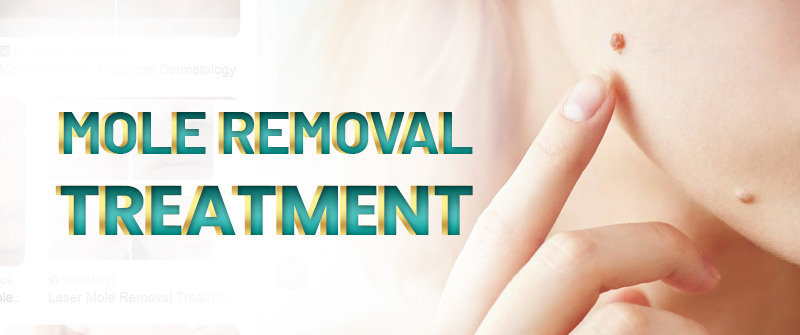
Mole Removal Treatment in Islamabad
If are you tired of numerous moles on your skin and want to clear your skin for aesthetic purposes then the Rehman Medical Center is your ultimate choice as the center holds a specialty in removing moles without any side effects.
Skin moles are tiny skin lesions. They consist of a group of melanocytes. A melanin-producing cell is a melanocyte. Skin color comes from a pigment called melanin. The majority of moles are skin-colored, but some can be much darker. They can be hairy, rough, flat, raised or all of the above. They typically have a smooth edge and are oblong or round. Both the look and size of moles can change. Sometimes they eventually stop or start to fade away. Some moles react to changes in hormone levels that can happen during pregnancy, adolescence, and older age. They typically increase in number during adolescence, darken during pregnancy and gradually disappear as we age. The majority of moles develop in the first 20 to 30 years of life, but some may already exist at birth. All moles that develop after birth are melanocytic nevi which are congenitally present at birth. People with dark skin typically have fewer moles than people with fair skin. No matter whether your skin is dark or fair, the Rehman Medical Center will address all your problems associated with moles and promise you the skin tone, texture, and appearance you want it to be.
Mole Removal
The mole is cut out of your skin during a mole removal procedure by your dermatologist. A physician who focuses on the diagnosis and treatment of skin conditions is known as a dermatologist. Your doctor can check the mole for skin cancer during a brief outpatient procedure. Additionally, some people remove moles for aesthetic purposes.
Any atypical mole on your face, neck, arms, legs, or torso can be treated with mole removal. Your doctor might advise having an abnormal mole removed so that a biopsy can be performed to determine whether the growth is cancerous (malignant) or precancerous. Mole removal may also be used as a curative procedure for skin cancer that hasn’t spread if your dermatologist is successful in doing so and achieves good margins (the region around the mole). If you don’t like the way a mole looks or is situated, your doctor may also remove it.
Mole Removal Treatments
The two primary techniques for removing moles are surgical excision and shave excision. Both types of mole removal surgeries have risks and advantages, just like any other surgical procedure. Discuss which approach is best for you with your dermatologists at the Rehman Medical Center and they will pay attention to your preferences more than their own.
Surgical Removal
For the removal of moles, excision is a widely used technique. Your surgeon will use a scalpel to cut your mole away from the surrounding skin after cleaning and numbing the area. To ensure that all of the abnormal cells are removed, they may take a margin of healthy skin depending on the type of mole. After grasping the segment with forceps, they raise the mole and remove it. Bleeding is common; your surgeon may cauterize the area or apply pressure to stop the bleeding before sewing the wound back together.
Excision by Shaving
Shave excision is another popular method for removing moles. Instead of cutting, your doctor may be able to remove a mole by shaving it. A sample of tissue from a shaving excision can be used for analysis, and once the wound has healed, most people are happy with the results. Shave excision, however, is ineffective for examining deep tumor margins and cannot be used to differentiate between various types of skin cancer. A single or double-bladed razor is used by your healthcare provider to carefully trim the growth to the level of the skin surrounding it during shave excision mole removal. To minimize any scarring that may occur after healing; they may lightly burn the area surrounding the mole that was removed.
In comparison to surgical excision, moles removed with a razor incision are slightly more likely to reappear.
Other Available Options
Despite the fact that some medical professionals have in the past removed moles with lasers, cautery, or liquid nitrogen (cryotherapy), these methods aren’t typically advised. If you employ these techniques there won’t be a sample of your mole available for analysis to determine the type of mole you have. Additionally, these treatments increase the likelihood that moles will return or recur. Skin cancer-like characteristics can occasionally be found in benign moles that return after nonsurgical removal.
Recovery Time After Treatment
The length of recovery depends on the size of the mole that was removed as well as your general health. Healing time following mole removal is most likely two to three weeks. You can go about your daily business during this time, but you might feel a little sore. You should adhere to your healthcare provider’s wound care instructions to encourage healing and prevent infection. Your wound needs to be kept clean, moist, and covered after the removal of the mole. As directed by your healthcare provider, change the dressing as needed, ideally every day. Apply sunscreen to the affected area whenever it is exposed after you have healed.
Potential Risks Associated with Mole Removal
A mole removal procedure performed in your dermatologist’s office is a low-risk procedure. However, there are some risks with every procedure. Mole removal procedures carry the following risks:
- Bleeding
- (May or may not be visible) scars.
- Infection
- Damaged nerves.
- It’s possible for the mole to recur.
These side effects or potential risks associated with mole removal become negligible when you get your treatment from the Rehman Medical Center because of the latest technology and highly experienced dermatologists available at the center.
Moles may not always look pleasant and some people have serious aesthetic concerns about their skin, therefore, mole removal treatments become their refuge. The Rehman Medical Center is offering mole removal services under the supervision of highly qualified and experienced dermatologists. The service charges are quite reasonable and the dermatologists individually attend to every patient to their fullest satisfaction.
